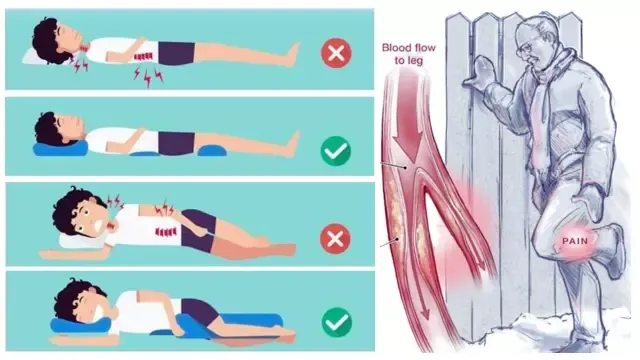Best Sleeping Position For Peripheral Artery Disease
Peripheral artery disease (PAD) is a condition that affects the blood circulation in the limbs, causing discomfort and pain. For individuals with PAD, finding the best sleeping position becomes crucial to promote better blood flow and alleviate symptoms.
In this article, we will explore some recommended sleeping positions that can help individuals with peripheral artery disease experience a more comfortable and restful night's sleep.
 |
| Best Sleeping Position For Peripheral Artery Disease |
🔖 Topic of Contents:
- Introduction
- What is Peripheral Artery Disease (PAD)?
- Causes of Peripheral Artery Disease
- The importance of a proper sleeping position for PAD patients
- Best Sleeping Positions for Peripheral Artery Disease
- Lifestyle Changes for Improved Sleep with PAD
- Conclusion
- FAQs
What is Peripheral Artery Disease (PAD)?
Peripheral Artery Disease (PAD) is a condition in which the arteries that carry blood to the extremities, such as the legs and arms, become narrowed or blocked due to the buildup of fatty deposits known as plaques. This narrowing or blockage restricts the flow of oxygenated blood to the affected areas, leading to symptoms such as pain, numbness, or weakness, especially during physical activity.
Causes of Peripheral Artery Disease
The primary cause of PAD is atherosclerosis, which occurs due to the accumulation of plaques within the arterial walls. Atherosclerosis is a progressive condition in which cholesterol, fat, calcium, and other substances build up on the inner lining of the arteries, forming plaques. Over time, these plaques can restrict blood flow, causing PAD.
Certain risk factors increase the chance of developing PAD. They include :
- Smoking: Tobacco use narrows the blood vessels and increases the formation of plaques, accelerating the progression of PAD.
- Age: PAD becomes more common as people age, especially individuals over 50 years old.
- Diabetes: High blood sugar levels can damage blood vessels and increase the risk of atherosclerosis.
- High blood pressure: Hypertension can damage and narrow the arteries, contributing to the development of PAD.
- High cholesterol: Elevated levels of LDL (low-density lipoprotein) cholesterol, often referred to as "bad" cholesterol, can lead to plaque formation.
- Obesity: Obesity increases the likelihood of developing atherosclerosis and PAD.
- Sedentary lifestyle: Lack of physical activity can contribute to the development of PAD.
- Family history: Having a family history of PAD or other cardiovascular diseases increases the risk.
- Race: African Americans have a higher risk of developing PAD than Caucasians.
- Certain medical conditions: Conditions such as kidney disease, peripheral neuropathy, or inflammation can increase the risk of PAD.
READ ALSO: How to increase vascularity?
The importance of a proper sleeping position for PAD patients
For patients with peripheral artery disease (PAD), maintaining a proper sleeping position is crucial due to its impact on blood circulation. A proper sleeping position helps to alleviate symptoms, improve blood flow, and prevent complications. Elevating the legs while sleeping can help reduce pain, swelling, and improve circulation. This allows for better oxygen and nutrient delivery to the affected limbs, supporting healing and overall health for PAD patients. Therefore, a proper sleeping position plays a vital role in managing PAD and promoting a better quality of life.
Best Sleeping Positions for Peripheral Artery Disease
Elevated legs:
Elevating your legs above heart level while sleeping helps improve blood circulation. Use pillows or a reclining bed to prop up your legs.
Side sleeping:
Sleeping on your side can relieve pressure on the affected blood vessels and improve blood flow. Place a pillow between your knees to support the alignment of your spine.
Fetal position:
The fetal position, where you curl up on your side with your knees drawn toward your chest, can also be beneficial for individuals with PAD. This position helps open up the blood vessels and promotes better blood flow.
Upper body elevation:
Raising the upper half of your body with pillows or by using an adjustable bed can minimize the impact of gravity on blood circulation. This position prevents blood from pooling in the lower extremities.
READ ALSO: How to increase hemoglobin level fast and naturally?
Lifestyle Changes for Improved Sleep with PAD
Regular exercise:
Engaging in regular exercise can help improve circulation and sleep quality. However, it is important to consult with a healthcare professional before starting any exercise regimen, as they can guide the appropriate type and intensity of exercise for PAD.
Weight management:
Maintaining a healthy weight is essential for managing PAD and improving sleep quality. Losing weight can reduce the strain on the circulatory system and improve blood flow throughout the body.
Quit smoking:
Smoking is a significant risk factor for PAD and can contribute to poor sleep quality. Quitting smoking can improve blood circulation and overall health, leading to better sleep.
Relaxation techniques:
Practicing relaxation techniques such as deep breathing exercises, meditation, or yoga before bed can help reduce stress and promote better sleep. These techniques can also help improve blood flow and reduce muscle tension.
Healthy sleep environment:
Creating a sleep-friendly environment can contribute to better sleep. Ensure the bedroom is dark, quiet, and at a comfortable temperature. Investing in a comfortable mattress and pillows that provide proper support may also aid in improving sleep quality.
Conclusion
There isn't a definitive "Best" sleeping position for individuals with Peripheral Artery Disease, the goal should be to prioritize comfort and optimize blood flow. It is recommended to avoid positions that restrict blood flow or put pressure on affected limbs.
Experimenting with different sleeping positions, such as elevating legs slightly or using extra pillows for support, may help alleviate symptoms and promote a more restful sleep.
However, it is important to consult with a healthcare professional to determine the most suitable sleeping position based on individual needs and medical condition.
Disclaimer: The information provided here is for general informational purposes only and is not intended to be a substitute for professional medical advice or treatment. Each individual's condition and requirements may vary, and it is essential to seek personalized medical guidance before making any changes to your sleep position or treatment plan. The content provided does not guarantee specific outcomes and any actions taken based on this information are solely at the reader's discretion and risk. We strongly recommend consulting with a healthcare professional for accurate diagnosis, personalized advice, and appropriate treatment recommendations for individuals with PAD or any related medical condition.
READ MORE:
⇒ How to make heart healthier?
⇒ How to increase AMH levels naturally?
⇒ How to increase blood flow to pennis naturally?
⇒ Apple cider vinegar and lemon juice healthy combination
Frequently Asked Questions
Which direction is best for sleeping?
It is said that sleeping facing east brings positive energy and connection with nature. Ultimately, the best direction for sleeping is the one that allows an individual to feel the most relaxed and restful.
What is the healthiest sleeping position?
It is generally recommended to sleep on the back, as it helps maintain spinal alignment and keeps the airway open. This position can help prevent wrinkles from forming and reduce acid reflux.
Can peripheral artery disease be cured?
Peripheral artery disease cannot be cured, but it can be managed and its progression can be slowed down. Treatment options typically focus on symptom management and reducing the risk of complications. These may include lifestyle changes such as quitting smoking, regular exercise, and a healthy diet. Medications may also be prescribed to control blood pressure, cholesterol levels, and prevent blood clots. In more severe cases, procedures such as angioplasty or bypass surgery may be required to improve blood flow.
Which sleeping position is good for heart?
Sleeping on your back is generally considered the best sleeping position for heart health.
What are 3 signs of peripheral arterial disease?
Intermittent claudication, Hair loss or slow hair growth on the legs, Cool or pale skin on the legs.
What is the best diet for peripheral artery disease?
The diet should emphasize fresh fruits and vegetables, whole grains, low-fat proteins (such as fish, chicken, and beans), and healthy fats (such as avocado, nuts, and olive oil). It is recommended to limit the intake of saturated and trans fats, cholesterol, sodium, and added sugars.
What vitamins to take for peripheral disease arteries?
Vitamin C, Vitamin E, Vitamin D, B vitamins, Omega-3 fatty acids, Coenzyme Q10.
What are the four stages of peripheral artery disease?
Asymptomatic PAD, Claudication, Critical limb ischemia, Gangrene.
What is the best exercise for peripheral artery disease?
Walking is the best exercise for peripheral artery disease. Walking is a low-impact exercise that increases blood flow to the legs and helps to improve circulation. It also helps to strengthen the muscles and reduce symptoms associated with peripheral artery disease.
What is the best treatment for peripheral artery disease?
This depends on the severity of the condition and individual patient factors. Treatment options may include lifestyle changes such as quitting smoking, adopting a healthy diet, regular exercise, and managing other underlying health conditions. Additionally, medications like antiplatelet drugs and cholesterol-lowering medications may be prescribed. In more severe cases, procedures like angioplasty or bypass surgery may be necessary to improve blood flow. The specific treatment plan should be discussed with a healthcare professional who can evaluate the condition and provide personalized recommendations.





